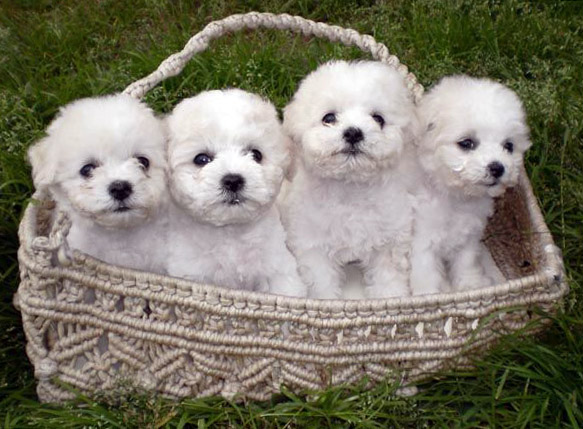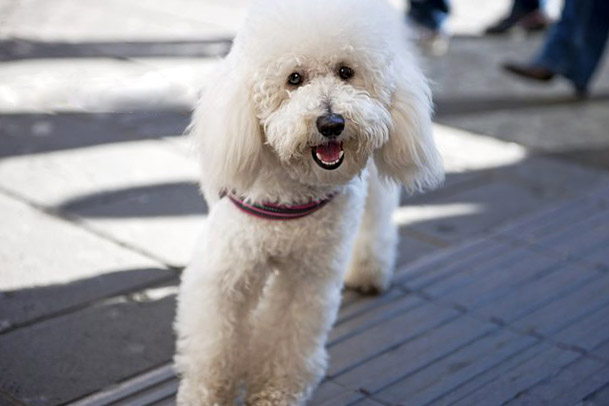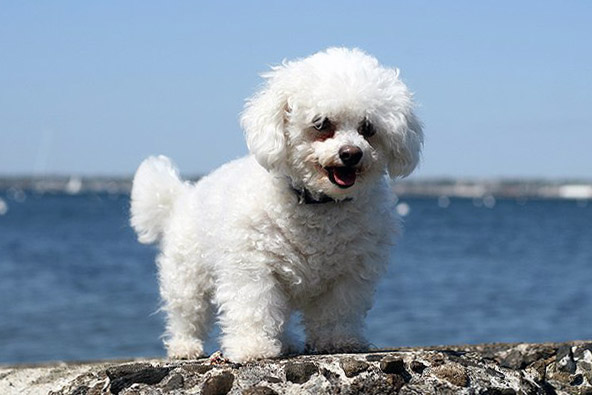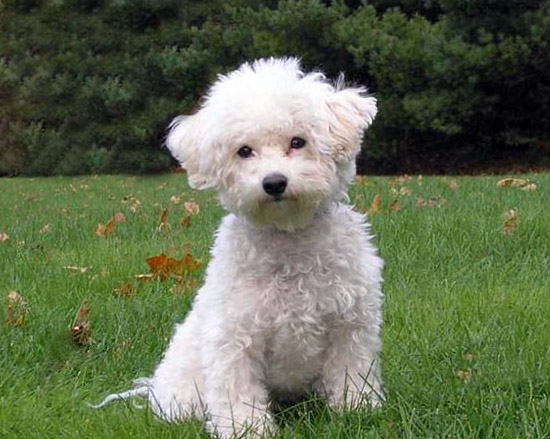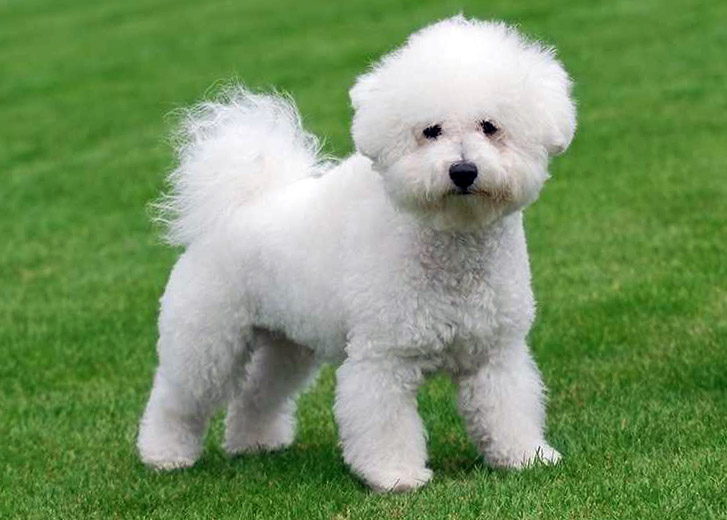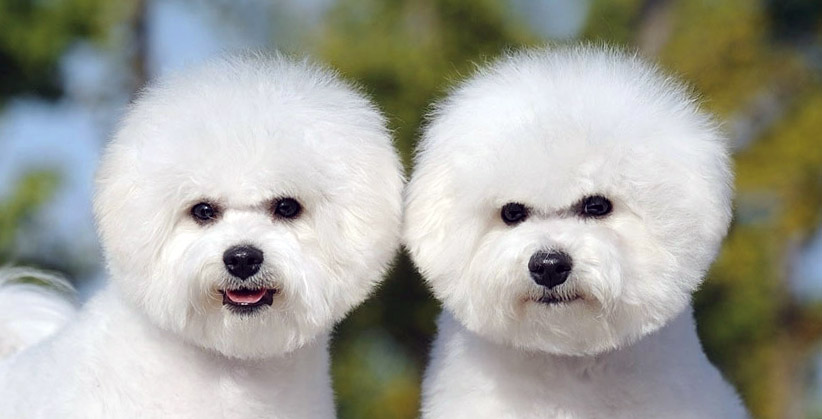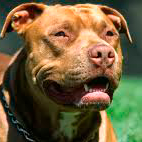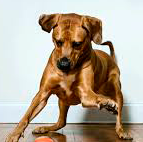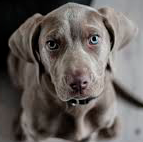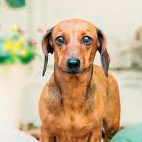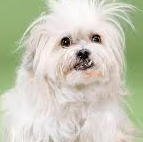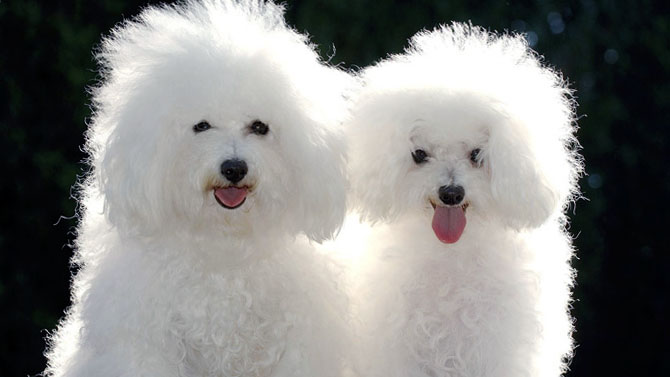
Bichon Frise
Origin
France / Belgium
This breed standard is accept by all great dog organizations
General Appearance: Lively and playful little dog, with a lively gait, medium length muzzle, long corkskrew-curled very soft hair, very like the fur of the Mongolian goat. Head carriage is proud and high, the eyes dark, lively and expressive. A beauty Bichon frise must have pure white hair …
Head: The skull longer than the muzzle, the head in harmony with the body.
Nose: The nose is rounded, black, finely grained and glossy.
Lips: The lips are fine, rather lean, less however than in the Schipperke, falling only enough so as to cover the lower lip, but never heavy nor pendulous; they are normally black up to the corner of the lips; the lower lip must not be heavy nor visible, nor soft and does not allow the mucous membranes to be seen when the mouth is closed.
Teeth: Bite normal, i.e. the incisors of the lower jaw are placed immediately against and behind the point of the teeth in the upper jaw.
Muzzle: The muzzle must not be thick nor heavy, without however being pinched; the cheeks are flat and not very muscular. The stop not very marked, the furrow between the superciliary arches slightly visible.
Eyes: Dark eyes, as much as possible with dark eyelids, of a rather round shape and not almond shaped; not placed obliquely; lively, not too big, not showing any white. Neither large nor prominent as in the Griffon Bruxellois and the Pekingese; the socket must not bulge. The eyeball must not stand out too much.
Skull: The skull is rather flat to the touch although the coat makes it appear round.
Ears: Drooping, well furnished with fine curly long hairs, carried rather forward when the dog is attentive, but in such a way that the front edge touches the skull and does not stand away obliquely; the length of the cartilage must not, like in the Poodle, extend to the nose, but stops halfway of the length of the muzzle. They are anyway not as wide and finer than the Poodle’s.
Neck: Reach of neck is fairly long, carried high and proudly. Round and fine near the skull, broadening gradually to merge smoothly into the shoulders. Its length is very approximately a third of the length of the body (proportion of 11 cm to 33 cm for a dog of 27 cm high); the points of the shoulder against the withers taken as basis.

Shoulder: The shoulder is fairly slanted, not prominent, giving the appearance of being the same length as the upper arm, about 10 cm; does not stand away from the body and the elbow in particular does not turn out.
Legs: Seen from the front, really straight and perpendicular; fine bone; the pastern is short and straight seen from the front, very slightly oblique seen in profile. The nails are preferably black; it is however an ideal difficult to obtain.
Chest: Well developed; the sternum is pronounced; the false ribs rounded and do not end abruptly, the chest having horizontally a rather great depth.
Flanks: The flanks are well tucked up at the belly; the skin is fine and not loose, giving quite a whippety appearance.
Loin: Loin broad and well muscled, slightly arched. The pelvis is wide, the rump is slightly rounded and the tail is set a little more below the back line than in the Poodle.
Thighs: The thighs are broad and muscular; lower thighs slanting. The hock is also more angulated than in the Poodle; feet sinewy.
Tail: Normally the tail is carried high and gracefully curved in line with the spine, without being rolled up; it is not docked and must not be in contact with the back; however the tail furnishings may fall onto the back.
Pigmentation: The pigmentation beneath the white coat is preferably dark; the genitals are then pigmented either black, bluish or beige.
Colour: Pure white.
Coat (Hair): Fine, silky, very loose corkscrew curls looking like the coat (fur) of the Mongolian goat, neither flat nor corded and 7 to 10 cm long.
Grooming: The dog may be shown with the feet and muzzle slightly tidied up.
SIZE: The height at the withers should not exceed 30 cm, the small size being an element of success.
Faults: Any departure from the foregoing points should be considered a fault and the seriousness with which the fault should be regarded should be in exact proportion to its degree.
- Pigmentation extending into the coat and forming rusty (red) patches.
- Coat flat, wavy, corded or too short.
- Slightly overshot or undershot mouth.
Eliminating Faults:
- Prognathism (undershot-overshot) so developed to the extent that the incisors do not touch.
- Pink nose.
- Flesh coloured lips.
- Light eyes.
- Rolled up tail or twisted in a spiral.
- Black spots in the coat.
N.B.: Male animals should have two apparently normal testicles fully descended into the scrotum.


